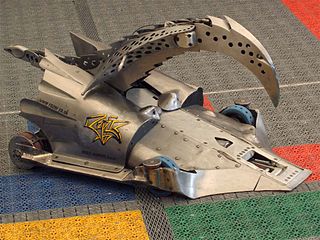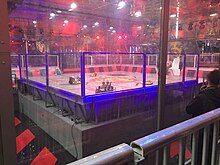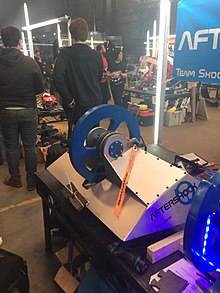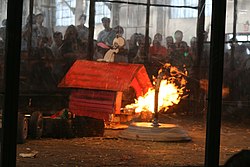
Robot-sumo, or pepe-sumo, is a type of robot combat in which two robots attempt to push each other out of a circle. The robots used in this competition are called sumobots.
BattleBots is an American robot combat television series and company. The show is an adaptation of the American Robot Wars competitions hosted in the mid–late 1990s by Marc Thorpe, in which competitors design and operate remote-controlled armed and armored machines designed to fight in an arena combat elimination tournament. The same competitions inspired the British TV program Robot Wars, which acquired the name in 1995.

Robot Wars is a robot combat competition that was broadcast on British television from 1998 to 2004 and from 2016 to 2018. Each series involves teams of amateur and professional roboteers operating their own constructed remote controlled robots to fight against each other in an arena formed of steel and bullet proof glass fitted with arena hazards and containing areas occupied by hostile and heavier "House Robots". Earlier series included assault and trial courses for competing robots.

Chaos 2 is a combat robot from the UK Television Series Robot Wars, designed and built by self-employed mechanic George Francis, from Ipswich, and operated by Team Chaos. Twice winner of the UK Robot Wars Championship and the only robot with that distinction, it was the first robot to use its flipper to throw its opponents out of the arena altogether. This machine was also the first to defeat Hypno-Disc in Series 3. Its flipper is commonly considered to be one of the most powerful in Robot Wars, although it is not as powerful as the catapult-style flipper of Wheely Big Cheese. However, its weapon is superior in terms of efficiency, but has a limited supply of CO2, which provides the power for the weapon. The robot has been reincarnated several times over the years, previously appearing as Robot The Bruce and Chaos. Its flipper was also used as a self-righting mechanism when the robot was inverted, flipping the entire robot over in a half-somersault so it could continue fighting.

Hypno-Disc was a contestant entry in the Robot Wars TV series, and was one of the first robots permitted to use the kinetic flywheel weapon. Hypno-Disc's design, however, was somewhat basic, and its high ground clearance made it an easy target for robots armed with flipping weapons, such as Chaos 2. Hypno-Disc was the creation of the Rose family — twin brothers Derek and David, and their father Ken. It was the first competitor robot recreated in toy form when the Robot Wars pullback toys were released.

Robotica is a robot combat show produced for the American television cable channel TLC, a subsidiary of the Discovery Channel, from April 4, 2001, to November 16, 2002. Ahmet Zappa and Tanya Memme hosted all three seasons while Tanika Ray only hosted the first season with Dan Danknick replacing her for the second and third seasons.
Roadblock was a combat robot that competed on the British television series Robot Wars. Constructed in 1997 by A-level students from Bodmin Community College, the robot was initially called "Road Rage" but was renamed in response to a request from the programme's producers. Both names were derived from the robot's distinctive construction from metal roadsigns. Roadblock was champion of the first series of Robot Wars and finished in third place for the second series. Although Roadblock was armed with a circular saw weapon, its success was primarily due to its wedge-shaped body—Roadblock could drive underneath opponent robots and invert them, rendering many immobile.

Razer is a combat robot that competes on the British television series Robot Wars. It was constructed by Simon Scott and Ian Lewis from Bournemouth; the team later expanded to include webmaster Vincent Blood. Razer was designed and constructed in 1998 to participate in the second series of Robot Wars, but subsequent modifications and improvements enabled it to remain competitive until its retirement after the second series of Robot Wars Extreme. Despite gaining a reputation for being unreliable, it was champion of the fifth series of Robot Wars, runner-up in the sixth, and won the first two Robot Wars World Championships.
Panic Attack was a robot that competed in the British television show Robot Wars. In Series 2, it was just a box, with a set of electrically powered lifting forks, powered by a homemade system. It was emblazoned with the image of a spider. The spider was the result of a school competition to come up with a design of something that made you panic. A 12-year-old girl designed the spider. With his prize money from Series 2, Kim built a newer machine. This one had a srimech, a new body shape, and more effective forks, which were capable of completely overturning opposing machines. The top-mounted self-righting mechanism proved to be unreliable, and was eventually removed. Added in Series 4 were a set of side "skirts" to prevent all but the lowest of robots from getting underneath it, as well as sloping sides. The fourth model had improved skirts, and the srimech was updated to a top flipper, which was the favourite with the driver Kim Davies, who stated it was, in his opinion, the best version.
Tornado was a competitor on the UK TV series Robot Wars, noteworthy as the champion of the sixth series. It was built by Andrew Marchant, Bryan Moss and David Gamble, from Sawtry, near Huntingdon.
Robot Arena is an action video game series focused on robot building and fighting. It is based on television shows such as Robot Wars and Battlebots. There are three games in the series, Robot Arena released in 2001, Robot Arena 2: Design and Destroy released in 2003, and Robot Arena 3 released in 2016.
Typhoon 2 was a robot in the UK television series Robot Wars, noteworthy for being the final champion of the show before it was cancelled. It was a full-body spinner with cutting claws. In two battles in series 7, in which it competed, it knocked out the arena wall, causing the match to restart. It was created by the 870 Dreghorn Squadron's Air Cadets from the Air Training Corps and was painted to resemble the RAF crest. It was named after the Eurofighter Typhoon. The team also had a three-time middleweight champion called Typhoon, a lightweight called Typhoon Thunder which also made Typhoon Twins with Typhoon Lightning, and a featherweight called Typhoon Cadet. Gary Cairns, the team captain, later ran a three-dimensional printing business and fought in the 2016 Robot Wars with PP3D, which reached the second round group stage in its heat. Then, it lost, ironically, to Storm 2 in the decisive battle, before losing at the same stage a year later due to control problems in its battles.
Blendo is a combat robot designed and built by Jamie Hyneman. Adam Savage wired the electronics and control systems.
BioHazard is a combat robot built by rocket scientist Carlo Bertocchini. It was the most successful robot in the heavyweight division of BattleBots. It is still considered one of the greatest and most successful combat robots of all time. BioHazard's weapon is an electric four-bar lifting arm used to lift other robots. The lifting arm has been described as a type of shovel, scoop, or a forklift mechanism. For much of its reign, BioHazard was notorious for being difficult to attack and get under due to hinged titanium wedge skirts on all sides and the low profile effected by its 4.5 inches (11 cm) height. The robot weighs 208 pounds (94 kg) and has a surface area of 3 feet (0.91 m) by 4 feet (1.2 m).
Storm 2 is a robot that competed in the British television game show Robot Wars. It was a small invertible box-shaped robot with a wedge on the front. The robot was originally built with no weapons but the team was asked to add an active weapon in order to take part in the seventh series, so the team came up with a built-in lifting arm, very similar to the American robot BioHazard. However, it was not the weapon but the immense speed and power of the robot that did the most damage to its opponents, managing to throw The Steel Avenger out of the Arena in its Series 7 heat final. The robot competed in the seventh series of Robot Wars, winning The Third World Championship at the end of the series, having won the 16th seed into the competition by being victorious in the New Blood Championship of Extreme 2.
In robot combat, a self-righting mechanism or srimech is a device used to re-right a robot should it get flipped. Biohazard of BattleBots was the first robot to self-right.
Robot Combat League (RCL) is a U.S. television show on the Syfy network about robot fighting competitions. On the show, teams use exosuits to control fighting robots. The series is hosted by Chris Jericho and was first shown on February 26, 2013, at 10pm EST.
Translational drift also known as melty brain or tornado drive is a form of locomotion, notably found in certain combat robots.

The eleventh season of the American competitive television series BattleBots premiered on Discovery Channel on January 6, 2022. This is the fourth season of Battlebots to premiere on Discovery Channel and the sixth season since the show was rebooted in 2015. The show continued to use their modified logo, with a pair of "B"'s, making a "BB" logo atop the term "BATTLEBOTS", as well as the subtitle, "Fight Night" for qualifying rounds.

The twelfth season of the American competitive television series BattleBots premiered on Discovery Channel on January 5, 2023. This is the fifth main-line season of Battlebots to premiere on Discovery Channel and the seventh main-line season since the show was rebooted in 2015; official material markets this season as World Championship VII.

















